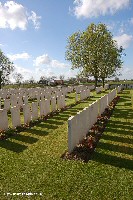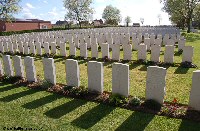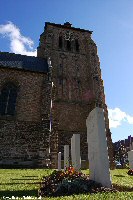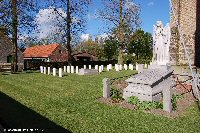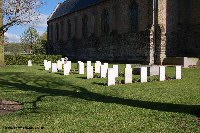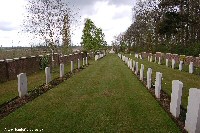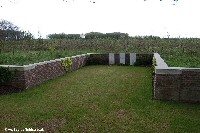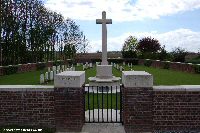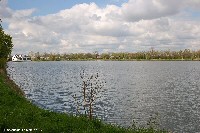Zillebeke and Surrounding Area
The World War One Battlefields site is undergoing a major update, with pages being converted to a new, user-friendly mobile format. The updated pages can be found at Updated World War One Battlefields. Some pages such as this one remain in the original format pending update.
The village of Zillebeke is located about one and a half miles south-east of Ypres, and there is a lake of the same name nearby. There are many sites of interest to be seen, both in the village and also in the surrounding area - so this page covers locations for some distances in all directions around the village. To reach the village, follow the N8 from Ypres (towards Hooge and Menen), and go right at the roundabout where it joins the N345 and N37, following the sign for Zillebeke. (This roundabout is on the location of what was the infamous 'Hellfire Corner').
Following this route, on the northern outskirts of the village are two cemeteries. The first is Perth Cemetery (China Wall), which is located on the left hand side of the road.
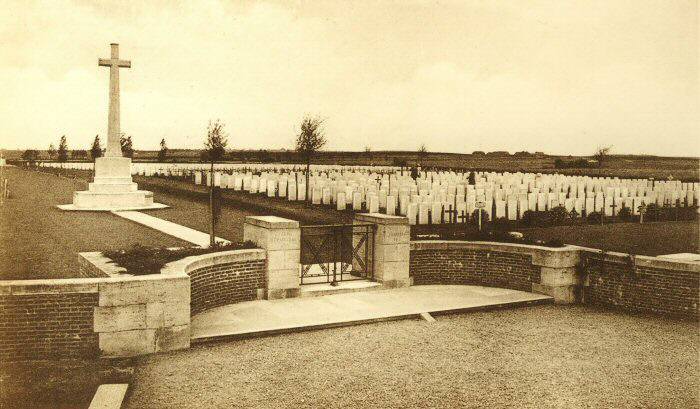
Perth Cemetery (China Wall) perhaps between the Wars. Photo: NELS
The words 'Perth Cemetery' are inscribed on the left of the entrance gateway, whilst 'China Wall' is inscribed on the right. The latter name comes from a communication trench which ran close by known as the Great Wall of China, whilst the name Perth probably originated with the 2nd Scottish Rifles, who took the cemetery over from the French in June 1917. It was also known during the war as Halfway House Cemetery. This is a large and intersting cemetery, and well worth spending some time on.
Just inside the cemetery is an old Belgian Police notice, which I have not seen in other cemeteries in the area. In three languages, this sets out a Belgian Royal Decree of regulations for Commonwealth military cemeteries, dated 23rd of June 1987. This also quotes the original September 1917 decree ceding land in perpetuity for military cemeteries, and a further agreement signed in July 1951.
The notice describes various activities which are forbidden within war cemeteries, including putting up notices on the walls or fences, climbing any wall or structure and organising political meetings. It also demands respect for the cemeteries, and bans any activities "incompatbible with the peace and dignity of the site or with the respect due to the dead". Those who infringe this, it cautions, may be imprisoned for 8-14 days or fined between 26 and 200 francs (although I am not sure what this would now be in Euros!).
Perth Cemetery (China Wall) stretches a long way back from the road and contains over 2,700 burials, about half of which are of unidentified soldiers. During the war, it was only used for around five months by the British, and there were only about 130 graves (within Plot 1).
Plot 1 (with the original wartime graves) is located at the back. These early burials have an irregular layout, but part of Plot 1 is of graves in regular rows. A photograph taken shortly after the War shows these graves, and this can be compared with todays view immediately below.
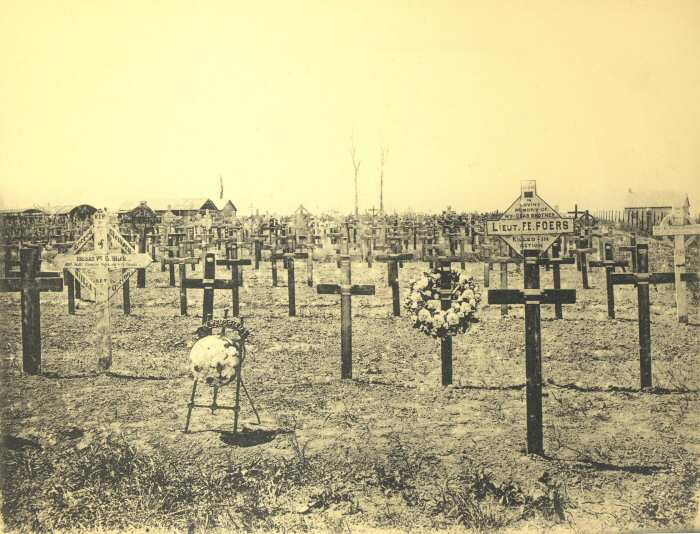
Perth Cemetery (China Wall) shortly after the War Photo: Van Winsen
After the Armistice, the cemetery was greatly enlarged by the concentration of graves, with more than 2,500 brought in from at least 28 smaller cemeteries and the surrounding battlefields. The original French graves were removed after the war. It would seem that the early photograph above predates the completion of the cemetery, as plots 9-15 to the right hand side do not appear to be present (a fence and a small shed are visible).
Two crosses in the early photograph show names that can be read; Private E. Blick and Lieutenant F.E. Foers.
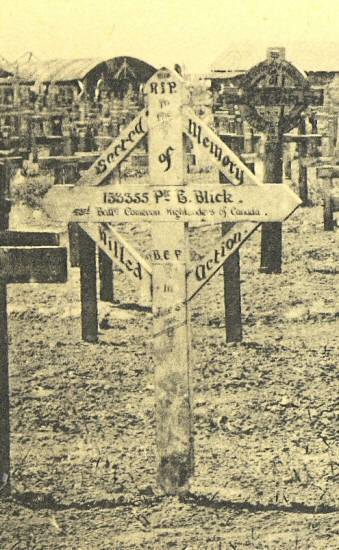
The original cross marking Private Blick's (real name Lloyd) grave. Photo: Van Winsen
There must be an interesting story behind Ernest Blick. This name still appears on the headstone, but it also records that this was an alias, and his true family name was Lloyd. Ernest Lloyd was born in Cheltenham England in about 1875, but it was the Canadian Expeditionary Force he enlisted in on the 5th of July, 1915. He died less than a year after he enlisted. He gave his next of kin as his sister, Mrs. Louise Fisher, of Cheltenham. However, the CWGC records that he was the husband of Ellen Lloyd, also of Cheltenham. He may have moved to Canada beforfe the War, returned to England to visit family and married. Perhaps there is another explanation behind why he used an alias and enlisted in Canada.
Whatever the story of his life, Ernest Lloyd, serving as Blick with the 43rd Canadian Infantry Battalion, was killed on the 3rd of June 1916, aged 41. The unit's war diary records that around midnight on the 3rd the battalion moved up to Zillebeke and that 6 soldiers were wounded. Blick/Lloyd may have been one of these; although no men were reported as killed that day, perhaps he died from his wounds shortly after (although the original cross reads "Killed in Action").
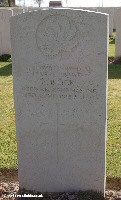
Headstone commemorating Private Blick (Lloyd) today
Whilst the original grave marker for Blick/Lloyd is non-standard, and probably an original war-time cross, the one to the right marking Lieutenant F.E. Foers grave in the early picture is a standard IWGC wooden cross, but with a personal marker attached to it's top.
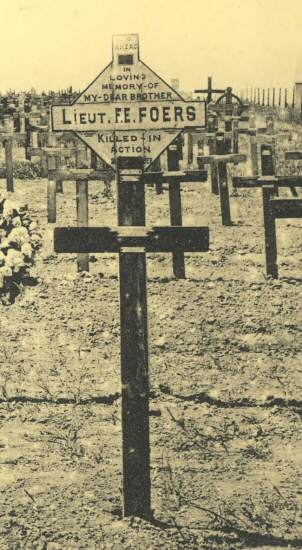
The original cross marking Lieutenant F.E. Foers' grave. Photo: Van Winsen
Second Lieutenant Frank Everest Foers enlisted in the ranks on the 29th of October, 1914. He was killed in action by machine gun fire on the 20th of September, 1917. The grave was originally recorded as "number 367", but is now Plot 1, Row G grave 47. His file at the Australian National Archives records that he was buried at Perth Cemetery "beside China Wall trench". He had served previously at Gallipolli, where he had been wounded in the left leg on Sunday August the 8th 1915, at Lone Pine.
The marker on top of the standard IWGC cross was put there by his brother, Roy Valentine Foers, who also served with the AIF, enlisiting in the Artillery after his brother was killed but not arriving on the Western Front until 10 days after the Armistice. Roy died in 1946.
In 1930 Frank Foers' father paid for a copy of the register of the cemetery where his son was buried. One imagines in those days it would have been very unusual for the family to able to visit France and see the grave.
The original photo of the cemetery showing Frank Foers' grave must have been taken prior to 1925, as in that year the Officer in Charge of records wrote to Walter Foers to report that the permanent headstones were being put up in Perth Cemetery (China Walls).
Today, the graves are all marked with the standard headstones. Although Foers grave appears to be positioned forward of the others in the row in the early photograph, today they are all in a straight line. Sadly, at the time I took these pictures, the inscription on Foer's headstone was so faint that the words could hardly be read, and I was unable to take a photograph that showed enough detail to add to this page.
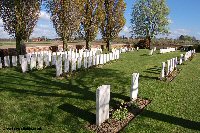
The wartime burials in Plot 1 at Perth Cemetery (China Wall)
Located between the graves of Blick/Lloyd and Foers is the grave of a Victoria Cross winner - Second Lieutenant Frederick Birks, of the 6th Battalion AIF. In the early photograph shown above, Second Lieutenant Birks' grave is to the left of the one with the wreath hanging on it. It is completely unadorned and with no special markings although there is an 'In Memoriam' wreath which may be in front of the grave.
Frederick Birks was commissioned as a Second Lieutenant on the 26th of April, 1917. He had enlisted on the 18th of August, 1914, and sailed from Australia on the Wiltshire on the 19th of October 1914. However, this was not the first time he had crossed the ocean, as he was born in Buckley near Chester in 1894, and his mother (listed as his next-of-kin) lived there until she died in late 1917. Frederick had two brothers, Samuel and John, and four sisters, Polly, Beatrice, Emily and Martha. There may have been a romantic interest in Australia, as a Miss Suzy Gelven of Langs Bay wrote twice to the authorities in 1917, concerned that she had not heard from Fred. Her letters date from well before he was killed however.
Frederick Birks was a Labourer, and aged just over 20 when he enlisted. He is described as having a dark complexion, hair and eyes. He trained at Broadmeadows Camp near Melbourne, which had only just been established and was then a "spartan and tented camp", and served initially as a Private with No. 2 Field Ambulance. He was wounded at Gallipolli, and later promoted, first to Lance Corporal and then to Corporal. He then served in France, and in October 1916 was awarded the Military Medal for "bravery in the field". He was posthumously awarded the Victoria Cross, for his actions during an attack on Glencourse Wood (about two miles from here) on the 21st of September, 1917. His official citation reads:-
For most conspicuous bravery in attack, when, accompanied by only a corporal, he rushed a strong point which was holding up the advance. The corporal was wounded by a bomb, but 2nd Lt. Birks went on by himself, killed the remainder of the enemy occupying the position, and captured a machine gun. Shortly afterwards he organised a small party and attacked another strong point which was occupied by about twenty-five of the enemy, of whom many were killed and an officer and fifteen men captured. During the consolidation this officer did magnificent work in reorganising parties of other units which had been disorganised during the operations. By his wonderful coolness and personal bravery 2nd Lt. Birks kept his men in splendid spirits throughout. He was killed at his post by a shell whilst endeavouring to extricate some of his men who had been buried by a shell.
Information in his service record at the Austalian National Archives confirms that he was killed by a shell in the morning of the 21st, whilst standing in an exposed position trying to help those who had been buried by the shell.
His headstone today has the symbol of the Victoria Cross engraved on it, and in June 1924, the Imperial War Graves Commission wrote to Australia asking the Base Records office of the AIF to check with Frederick Birks next of kin as to whether the proposed design met with their approval. Their letter was returned to London, suggesting they contact the next of kin (Frederick's elder brother, Samuel) directly, as he lived in Buckley. Their mother, Mary Birks had died aged 59 towards the end of 1917, her own death perhaps hastened by that of her son in September.
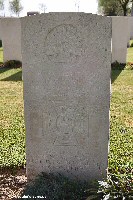
The grave of Second Lieutenant Frederick Birks, VC, MM
There are fields to the left and the rear of the cemetery, with a new brick built office building to the right. In row 6A, a single headstone marks the burial of ten unknown soldiers (picture below).
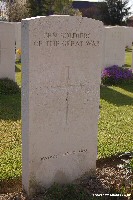
Headstone commemorating ten soldiers of the Great War
At the front right of the cemetery are special memorial headstones arranged in an extended loop. There are three larger memorial blocks which give more information. These special memorials commemorate 108 soldiers who were buried in a number of other cemeteries, including Wallemolen German Cemetery (near Passchendaele) plus a number of other German cemeteries and also Trench Railway Cemetery and Durham Cemetery (both were in Zillebeke, the latter quite near to here). There graves were destroyed by later fighting, so each man is commemorated by a special memorial stone in this loop.
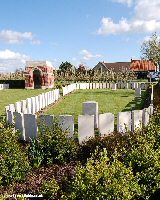
The loop of special memorial headstones at the front of the cemetery
It must have been doubly hard for the families of those who died to visit in these situations; to see a 'headstone' with their loved one's name on, but knowing that this did not in fact mark the grave. Some of the inscriptions are especially moving, for example that on Private B. Harding's grave reads "He nobly fell for the love of all. From his broken-hearted mother". As these soldiers do have headstones naming them, their names do not appear on the Menin Gate.
Also of interest is the fact that several men who were executed during the Great War are buried here.
Travelling a little further south, Tuileries British Cemetery can be found up a small grass track off to the right of the road. The name means tileworks, and comes from the works that were located near here before the war. The cemetery was started in 1915, but later on many of the graves here were destroyed by shelling. Only the locations of 26 graves are still known, and these are in rows A-D at the front. Sixteen of these are the graves of unknown soldiers.
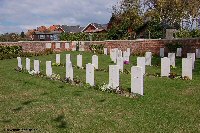
The known graves at Tuileries British Cemetery
There are special memorial headstones for the 69 Commonwealth and two French soldiers whose graves were destroyed, and these are arranged around the edges of the cemetery, with the Cross of Sacrifice thus standing in a lawned area in the centre.
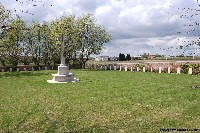
Special memorial stones line the edges of Tuileries British Cemetery....the original graves were destroyed by shelling
Zillebeke Village
Travelling a little further south, you reach the centre of the village. There are war graves to be found in Zillbeke Churchyard, and these are of great interest. The church is located to the left of the road as you travel south.
The CWGC graves are at the front left of the church yard. There are many early casualties of the war buried here, with several members of the aristocracy among them. Very unusually, there are two non-standard headstones to be seen here. They can just be picked out among the standard headstones in the general views below.
Second Lieutenant Baron Alexis George de Gunzberg was Russian born but lived in Paris. He was killed on the 6th of November 1914, serving with the 11th Hussars. The tombstone bears the imprint of the stonemason of Ypres who made it.
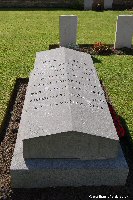
The tombstone of Second Lieutenant Baron de Gunzberg at Zillebeke Churchyard
The other unusual headstone here is that of Lieutenant Lee Steere, of the Grenadier Guards. The private memorial stone stands rather incongruously at the end of a short row of standard headstones.
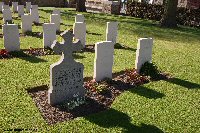
The tombstone of Lieutenant Lee Steere, alongside standard CWGC headstones
John Henry Gordon Lee Steere died on the 17th of November 1914. The CWGC records state he was with the 3rd Battalion of the Grenadier Guards, but his headstone states the 2nd Battalion. He was aged 19, and already married when he died.
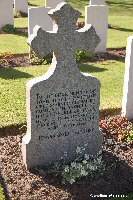
The grave of Lieutenant Lee Steere
Some of the standard headstones within the churchyard are very weathered and difficult to read. At the very front of the churchyard are two special memorials which commemorate soldiers who were buried here, but whose graves were destroyed by shellfire. They could be from two extremes of the British social spectrum before the Great War. One is Lieutenant The Honourable William Reginald Wyndham, third son of the 2nd Baron Leconfield. He joined the Life Guards in August 1914 and was killed in action on the 6th of November 1914. The special memorial next to his commemorates Private William Stewart of the Royal Scots, who died on the 16th of December 1915. Private Stewart was almost half the age of the Honourable Lieutenant Wyndham; and his inscription simply reads "There is a world above where parting is unknown". Both men were buried somewhere in this churchyard over 90 years ago, and despite their probable social differences, both made the ultimate sacrifice for their country.
One notices when walking in Flanders that shells are still recovered from the fields; remnants of the war that raged here. They are still dangerous today, and were even more so just after the war when there were far more of them and the land was being reclaimed by the locals following four years of devastation. In September 1921, a shell exploded at Zillebeke when some workmen were levelling the ground. It killed four of the Belgian workmen, injuring four others seriously.
South of Zillebeke
The road south through the village then forks to lead left or right. Following the right turn, after about a third of a mile at a T-junction is one of the Demarcation Stones erected after the war by the Touring Clubs of Belgium and France. Like many others that still remain, the carving has faded, but the outline of the helmet and the waterbottle on the side can be made out.
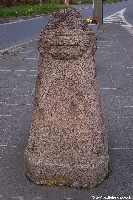
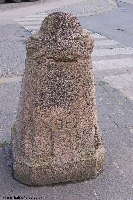
Two views of the Demarcation Stone at Zillebeke
In the garden of a house by this junction are the remains of what appears to be an "elephant-iron" covered bunker.
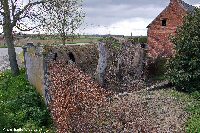
'Elephant-iron' bunker in a garden at Zillebeke
Turning left at the T-junction leads along small, but well signed roads to a place where you can park your car and walk to three isolated and peacuful cemeteries. These are close to a famous feature known as The Bluff.
A grass track leads from the small road to reach Woods Cemetery, 1/DCLI Cemetery and Hedge Row Trench Cemetery. This is quite an isolated area, but popular with walkers and families. The grass track leads straight on to Woods Cemetery, whilst another track leads off to the right to the other two cemeteries.
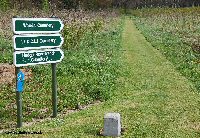
Sign to three smaller cemeteries near Zillebeke
Woods Cemetery is arranged with a long 'stem' leading to the Great Cross, and then a wider part fans out to the left of it. The front line was just beyond the wood, hence the irregular layout of the cemetery. It is about as remote and peaceful as can be found in this area - so many cemeteries in the Salient are now built around, but this remains in open country and woodland.
The cemetery was started by the 1/Dorsets and 1/East Surreys in April 1915 and was used until September 1917. Three RFA burials from the 12th of November 1917 are alone in a little spur leading off to the left of the larger end of the cemetery - this is described by Paul Reed in Walking the Salient as a field grave, perhaps a shell-hole where these men were originally buried. On the opposite side are the graves of two 8/Post Office Rifles soldiers, Riflemen Edwin Helps and E C Evans, killed on the 15th of December 1916.
The cemetery is on two tiers; by the Cross of Sacrifice two sets of steps lead down either side to the lower, wider part. There is an intermediate level here, with two graves on each side.
Returning along the grass track back towards the road, another track (signposted) leads uphill to 1/DCLI Cemetery (listed as First DCLI Cemetery on the CWGC website). This is a very small cemetery containing 76 graves, with no register on site. There are only four rows of graves; the three facing great cross almost exclusively of First Battalion Duke of Cornwall's Light Infantry (DCLI) men who died in May and June 1915 and are original wartime burials. They were involved in fighting at The Bluff, about half a mile south-east from here. The other row, Row D, at the back of the cemetery contains the graves of men from other units, which were brought in after the Armistice.
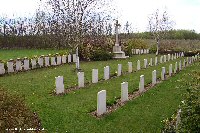
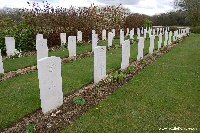
1/DCLI Cemetery: general view (left) and the rows of 1/DCLI men buried here (right)
The grass track continues to left of 1/DCLI Cemetery, and then leads to the right round woodland, giving good views over the surrounding area. It then runs uphill to Hedge Row Trench Cemetery. This again was an original wartime cemetery, sometimes known as Ravine Wood Cemetery. Once again, this is a small cemetery with just under a hundred buried here, men who died between March 1915 and August 1917. The register can be found in a box located on the outside edge of the left gatepost. The layout of this cemetery is unusual; the headstones are arranged around the edges (four short rows, one on each side) and in a circle around the Cross of Sacrifice. On each headstone are the words "Known to be buried in this Cemetery" - and even the headstones of unidentified soldiers have these words on them.
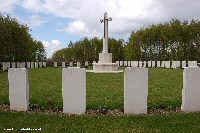
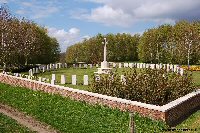
Hedge Row Trench Cemetery: grave locations are not known, so the 'headstones' are arranged in a circle
The reason for this is that after the burials were made the cemetery was very badly damaged by shellfire, and later the original positions of the graves could not be determined. Hence, the cemetery was designed by J Truelove in the symmetrical layout seen today; none of the headstones marking actual graves. There is an information board outside the cemetery which also explains this in Flemish and French. A truly tranquil spot, and a good place to spend a few minutes reflecting on the sad fact that the men buried here were denied actual grave markers due to the fighting that continued after their deaths.
Returning to your car, and driving back the way you came, pass the T-junction where the demarcation stone is located and continue straight on. Another small cemetery can be found down a small track leading left, downhill, to both the cemetery and a private house. This is Blauwepoort Farm Cemetery.
There is a herd of small goats in a pen in front of the cemetery, and the stone wall of the farm garden now joins directly up with the cemetery wall. On trench maps, the farm name was spelt as two words - Blauwe Poort - and at that time there was a small moat around three sides of the farm buildings.
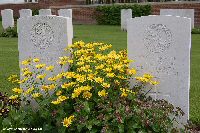
Graves at Blauwepoort Farm Cemetery
There are 82 graves here, and the register can be found in the small arched structure to the left of the gate. The layout of graves is somewhat haphazard, indicating this is a wartime cemetery with what appear to be odd gaps between some graves. The cemetery was originally started by the French in November 1914, taken over by the British in February 1915 and used for a year or so. The French graves were removed after the Armistice. Some of them may be visible in the front left in the early photograph of this cemetery shown below, as there seem to be more graves in the first visible row than can be seen today. The photo is believed to date from the early 1920s, and there are remarkably few differences in the same view today, apart from the building of the cemetery wall.
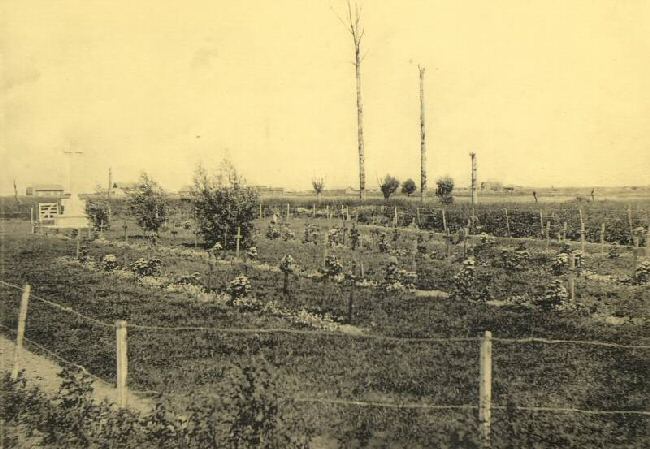
Blauwepoort Farm Cemetery shortly after the War Photo: Van Winsen
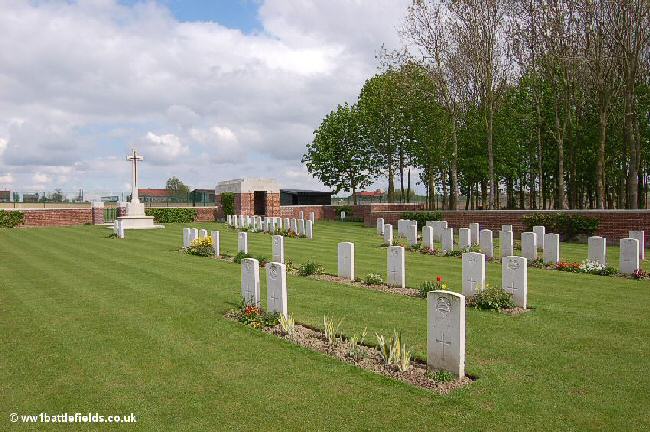
A similar view of Blauwepoort Farm Cemetery today
Returning to the road and continuing north-west, on the left of the road is one of the larger cemeteries in the salient, Railway Dugouts Burial Ground (Transport Farm). Both names were used during the war.
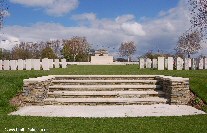
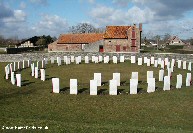
Railway Dugouts Burial Ground (Transport Farm) general view (left) and special memorial 'headstones' arranged in a circle (right)
The name derives from the dugouts located in the railway embankment that was located here during the war. Siting dugouts on the side away from the Germans protected them from artillery fire. The railway still passes today, and trains can be seen rushing past the cemetery from time to time. It is a large and complex cemetery, with among other features a small lake partly in and partly outside the cemetery (shown below). There is also a circular arrangement of special memorials (shown in the photo above right) to men who were buried in Valley Cottages Cemetery and Transport Farm Annex whose graves were destroyed in fighting during the war.
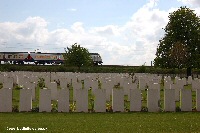
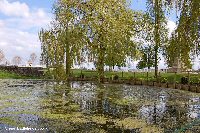
Trains still pass the cemetery, and a lake is among the features of this large cemetery
The cemetery was started in April 1915, and must have been quite large by the end of the war. There are just under 2,500 buried or commemorated here, only around 400 of whom were brought in after the Armistice. As an Advanced Dressing Station was located here for part of the war, the large numbers are not surprising. Many of the original burials would be of those who survived long enough to be sent or brought back from the front line, but who succumbed to their wounds at the ADS.
The picture below shows the cemetery as it appeared just a few years after the War, probably in the early 1920s. It is possible to determine the spot the photo was taken from, which is from the left rear of the cemetery, between plots 6 and 7.
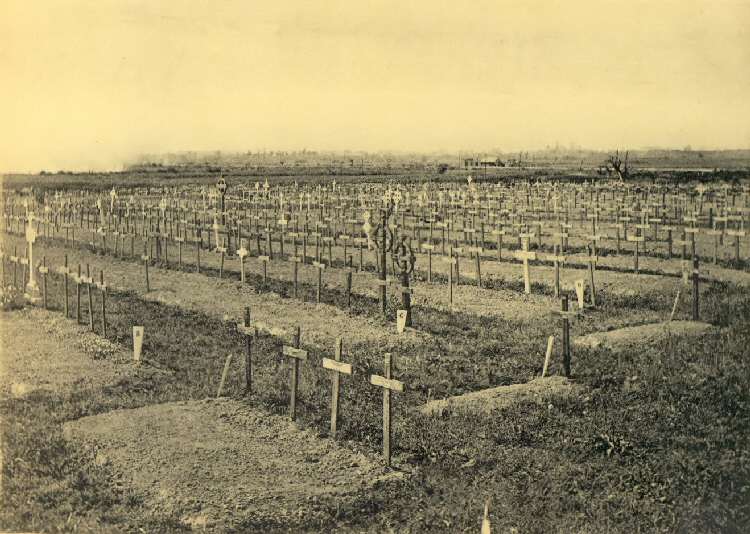
Early picture of Railway Dugouts Burial Ground (Transport Farm). Photo: Van Winsen
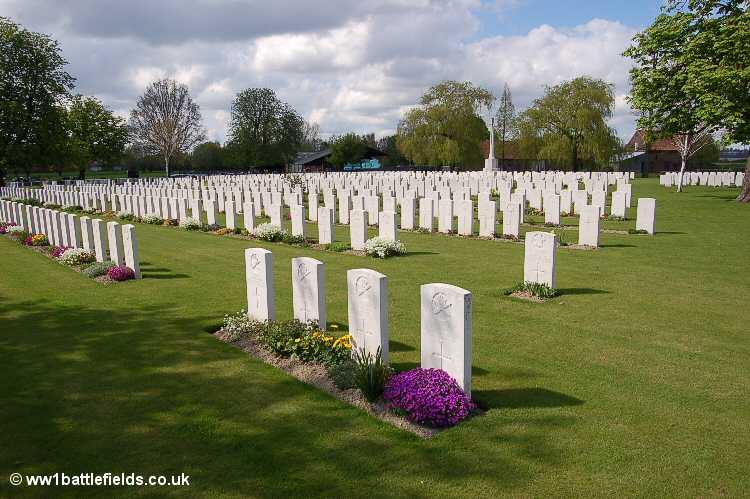
The same view today
The layout of the graves can be matched; the four headstones in the foreground are to men of the 68th and 69th Machine Gun Corps who died on the 7th of January 1917. They are Privates G Brown (a Military Medal winner) and Charles Leggett, Company Sergeant Major John Bunning and Lance Serjeant R Hamlet. The early photo is captioned 'Transport Farm', and as stated above the two names were both used for the cemetery. On the early photo, one grave, the cross apparently in between rows B and C, seems to have been moved when compared with today as the rows are straight.
There is one German headstone in a the far right corner by itself, with three names on it. Just inside the left entrance, and to the left of it are four Indian graves. The cemetery wall behind these was damaged when I was last there in May 2006. There is also a large double circle of special memorial stones around the Great Cross, commemorating those known to be buried here but where the location of the grave is no longer known. Many of these may relate to an incident in the summer of 1917, when many graves had not been marked when they were destroyed be shelling.
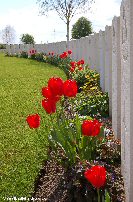
Graves at Railway Dugouts Burial Ground (Transport Farm)
On the opposite side of the road from the cemetery, a well-preserved bunker can be seen. Just a little to the south-east of it was Transport Farm Annex Cemetery, which contained 27 British burials. These graves were moved after the Armistice to Perth Cemetery (China Wall) - see above.
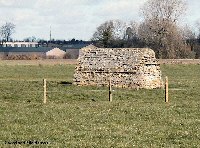
Bunker near Railway Dugouts Burial Ground (Transport Farm)
Just before Railway Dugouts/Transport Farm Cemetery, a road leads off to the north, signposted to a restaraunt. This road leads past Zillbeke lake and it is possible to walking on paths round the lake. During the war the path by bthe lake was a route used by the troops to reach the front line.
Sources & Acknowledgements
Australian War Memorial website
Commonwealths Wargraves Commission website
Great War Forum
Major & Mrs Holt: Battlefield Guide to the Ypres Salient
National Archives of Australia website
Paul Reed: Walking the Salient
Michael Scott: The Ypres Salient
The Times archives

